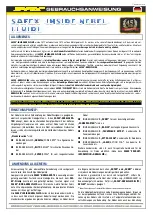
CONVENTIONS
The following conventions were used when writing this manual.
Keynames
These have been printed in a bold typeface.
For example: When you see a command in bold such as " Start " means "Press
the Start key on the operation panel".
If you see something like " # x 3", this means that you have to press the # key
3 times.
On the operation panel, there are four arrow keys (up, down,
left, right). This is the scroll key. It is often used in the operating
procedures to gain access to various features. For example, if
you see
in the manual, you are being asked to press the
right-pointing arrow (
) on the scroll key.
Displays
Messages seen on the display are shown in a larger box, normally on the right
hand side of the page, directly opposite the step that brought it up on the screen.
After following a step in a procedure, check the display to see if it corresponds to
the one in the manual. This may help you to check whether you are following the
procedure successfully. The following examples show three common types of
display.
Example A:
The keys that can be pressed are
shown on the upper right of the display. In this
example, you can press the Yes and
and
on
the scroll key.
Example B:
The choices of settings for a
feature are shown on the screen. The current
setting is indicated ( It is set ON). If you press
the
or
on the scroll key, the setting will be
changed to OFF.
Example C:
The
in the upper right of the
display indicates that you can input letters
using the Quick Dial Keys, and
and
on the
scroll key.
HO
W
T
O
USE
TH
IS
M
A
N
U
A
L
HOW TO USE THIS MANUAL
CONVENTIONS
5
















































